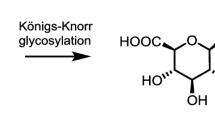Abstract
Reduced haloperidol (RHAL) is the best known metabolite of haloperidol (HAL), having been identified in humans, rats, and guinea pigs. Since RHAL contains an asymmetric center, it can exist in two possible enantiomeric forms. However, the enantiomeric composition of the RHAL formed from HAL in vivo has never been reported. As a first step toward the enantiomeric analysis of biological samples, we have developed an efficient and stereospecific synthesis of (+)- and (–)-RHAL from readily available commercial materials. We have also identified an enantioselective chromatographic method using a chiral HPLC stationary phase which can detect as little as 1% of either enantiomer in synthetic samples of RHAL enantiomers.
Similar content being viewed by others
REFERENCES
A. Forsman, G. Folsch, M. Larsson, and R. Ohman. On the metabolism of haloperidol in man. Curr. Ther. Res. 21:606–617 (1977).
W. D. Bowen, E. L. Moses, P. J. Tolentino, and J. M. Walker. Metabolites of haloperidol display preferential activity at sigma receptors compared to dopamine D-2 receptors. Eur. J. Pharmacol. 177:111–118 (1990).
A. Forsman and M. Larsson. Metabolism of haloperidol. Curr. Ther. Res. 24:567–568 (1978).
B. E. Pape. Isolation and identification of a metabolite of haloperidol. J. Anal. Toxicol. 5:113–117 (1981).
E. R. Korpi, J. E. Kleinman, D. T. Costakos, M. Linnoila, and R. J. Wyatt. Reduced haloperidol in the post-mortem brains of haloperidol-treated patients. Psychiat. Res. 11:259–269 (1984).
E. R. Korpi and R. J. Wyatt. Reduced haloperidol: Effects on striatal dopamine metabolism and conversion to haloperidol in the rat. Psychopharmacology 83:34–37 (1984).
E. R. Korpi, D. T. Costakos, and R. J. Wyatt. Interconversion of haloperidol and reduced haloperidol in guinea pig and rat liver microsomes. Biochem. Pharmacol. 34:2923–2927 (1985).
B. S. Chakraborty, J. W. Hubbard, E. M. Hawes, G. McKay, J. K. Cooper, T. Gurnsey, E. D. Korchinski, and K. K. Midha. Interconversion between haloperidol and reduced haloperidol in healthy volunteers. Eur. J. Clin. Pharmacol. 37:45–48 (1989).
K. K. Midha, J. K. Cooper, E. M. Hawes, J. W. Hubbard, E. D. Korchinski, and G. McKay. An ultrasensitive method for the measurement of haloperidol and reduced haloperidol in plasma by high-performance liquid chromatography with coulometric detection. Ther. Drug Monit. 10:177–183 (1988).
M. Hariharan, E. K. Kindt, T. VanNoord, and R. Tandon. An improved sensitive assay for simultaneous determination of plasma haloperidol and reduced haloperidol levels by liquid chromatography using a coulometric detector. Ther. Drug Monit. 11:701–707 (1989).
L. Ereshefsky, C. M. Davis, C. A. Harrington, M. W. Jann, J. L. Browning, S. R. Saklad, and N. R. Burch. Haloperidol and reduced haloperidol plasma levels in selected schizophrenic patients. J. Clin. Psychopharmacol. 4:138–142 (1984).
S. R. Bareggi, M. Mauri, R. Cavallaro, M. G. Regazzetti, and A. R. Moro. Factors affecting the clinical response to haloperidol therapy in schizophrenia. Clin. Neuropharmacol. 13:S29–S34 (1990).
W. H. Chang, T. Y. Chen, C. F. Lee, W. H. Hu, and E. K. Yeh. Low plasma reduced haloperidol/haloperidol ratios in Chinese patients. Biol. Psychiatry 22:1406–1408 (1987).
A. Weil, J. Caldwell, J.-P. Guichard, and G. Picot. Species differences in the chirality of the carbonyl reduction on [14C]fenofibrate in laboratory animals and humans. Chirality 1:197–201 (1989).
S. Barany, A. Ingvast, and L. M. Gunne. Development of acute dystonia and tardive dyskinesia in Cebus monkeys. Res. Commun. Chem. Pathol. Pharmacol. 25:269–279 (1979).
T. G. Heffner, D. A. Downs, L. T. Meltzer, J. N. Wiley, and A. E. Williams. CI-943, a potential antipsychotic agent. I. Preclinical behavioral effects. J. Pharmacol. Exp. Ther. 251:105–112 (1989).
J. Chandrasekharan, P. V. Ramachandran, and H. C. Brown. Diisopinocampheylchloroborane, a remarkably efficient chiral reducing agent for aromatic prochiral ketones. J. Org. Chem. 50:5446–5448 (1985).
M. Srebnik, P. V. Ramachandran, and H. C. Brown. Chiral synthesis via organoboranes. 18. Selective reductions. 43. Diisopinocampheylchloroborane as an excellent chiral reducing reagent for the synthesis of haloalcohols of high enantiomeric purity. A highly enantioselective synthesis of both optical isomers of tomoxetine, fluoxetine, and nisoxetine. J. Org. Chem. 53:2916–2920 (1988).
S. Yamaguchi and K. Kabuto. Effects of neighboring functional groups in the asymmetric reduction of ω-substituted alkyl phenyl ketones with lithium tri-1-menthoxyaluminum hydride. Bull. Chem. Soc. Jap. 50:3033–3038 (1977).
T. H. Chan and P. Pellon. Chiral organosilicon compounds in synthesis. Highly enantioselective synthesis of arylcarbinols. J. Am. Chem. Soc. 111:8737–8738 (1989).
H. Y. Aboul-Enein and M. R. Islam. Structural factors affecting chiral recognition and separation on cellulose based chiral stationary phases. J. Liq. Chromatogr. 13:485–492 (1990).
Author information
Authors and Affiliations
Rights and permissions
About this article
Cite this article
Jaen, J.C., Caprathe, B.W., Priebe, S. et al. Synthesis of the Enantiomers of Reduced Haloperidol. Pharm Res 8, 1002–1005 (1991). https://doi.org/10.1023/A:1015800923078
Issue Date:
DOI: https://doi.org/10.1023/A:1015800923078




